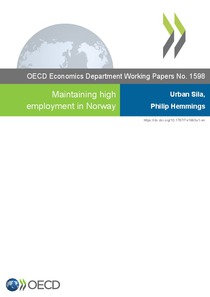Maintaining high employment in Norway

Sila, Urban ; Hemmings, Philip
Organisation for Economic Co-operation and Development, Paris
OECD Publishing - Paris
2020
66 p.
employment ; labour market ; sick leave ; disability ; early retirement ; educational policy ; immigrant
OECD Economics Department Working Papers
1598
Employment
https://doi.org/10.1787/7e1993a1-en
English
Bibliogr.
Norway has a well-functioning labour market with high employment and a compressed wage distribution, contributing to low inequality. Norway nevertheless faces challenges from a trend decline in employment rates among the young and prime-age men. Furthermore, immigrants and people with disabilities have significantly poorer labour market outcomes than rest of the population. Norway still faces comparatively high sick-leave absence and the share of the working-age population on disability support remains large. Relatively high school dropout rates are also of concern, in particular as opportunities for workers with low educational attainment are limited in the Norwegian labour market. This paper first describes the labour market and identifies its main strengths and weaknesses and then goes on to discussing policy areas to boost employment and ensure quality jobs for the future. These include reforms to i) sick-leave compensation and disability support, ii) early retirement incentives in old-age pensions; iii) education and skills; and, iv) integration of immigrants."
Digital
The ETUI is co-funded by the European Union. Views and opinions expressed are however those of the author(s) only and do not necessarily reflect those of the European Union or the ETUI.